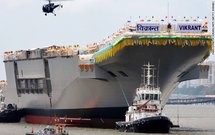 India launched the Indian Navy Ship Vikrant with much fanfare on Aug. 12 from a dry dock in the city of Kochi. The INS Vikrant is the first vessel of the Indigenous Aircraft Carrier program -- India's effort to design and build its own aircraft carriers. The launch of the 40,000-ton INS Vikrant is a noteworthy milestone in the development of the Indian navy, highlighting the progress made thus far in New Delhi's shipbuilding and maritime efforts. However, the INS Vikrant continues to be hampered by numerous obstacles, including problems that plague Indian carrier development in general.
India launched the Indian Navy Ship Vikrant with much fanfare on Aug. 12 from a dry dock in the city of Kochi. The INS Vikrant is the first vessel of the Indigenous Aircraft Carrier program -- India's effort to design and build its own aircraft carriers. The launch of the 40,000-ton INS Vikrant is a noteworthy milestone in the development of the Indian navy, highlighting the progress made thus far in New Delhi's shipbuilding and maritime efforts. However, the INS Vikrant continues to be hampered by numerous obstacles, including problems that plague Indian carrier development in general.
India has a long and proud carrier aviation tradition, dating back to its acquisition of the first INS Vikrant (formerly HMS Hercules) in 1961. Unlike China, India has decades of experience with flattops and carrier aviation. However, New Delhi has also never embarked upon as ambitious a development of its carrier force as in the past decade. India not only plans to significantly increase the size and quality of its carrier force, but it also intends to rely extensively on domestic construction in its shipyards.
With such ambitious plans and inexperienced domestic shipyards, problems and delays were to be expected. However, the Indian naval carrier program has faced significant cost growth in addition to the consistent delays. The Aug. 12 launch of the INS Vikrant comes almost four years behind schedule, and the vessel is only approximately 30 percent complete; it will likely miss its current 2018 commissioning date by at least another two years. Every extra year the carrier spends in dry dock being fitted with the propulsion system, equipment and weaponry involves another year of cost growth beyond the original budget. In fact, INS Vikrant is already projected to cost almost five times the figure estimated when the project was first approved. The carrier is also hardly of completely indigenous build, with a significant portion of components imported from abroad.
Unfortunately for the Indian navy, the indigenous aircraft carrier effort is not the only carrier program facing significant delays and cost growth. As part of India's plans to field a force of three carriers by 2020 -- one carrier for each seaboard and one carried in reserve/refit -- New Delhi had purchased the INS Vikramaditya, a modified Kiev-class aircraft carrier, from Russia. Originally set to be delivered in August 2008, the INS Vikramaditya has faced consistent delays, faulty machinery and cost growth, and is now slated to be delivered by the end of 2013 at more than double its original price.
The INS Viraat, currently the sole aircraft carrier in Indian naval service, was to be retired with the commissioning of the INS Vikramaditya. But with the delays in the launch of the INS Vikramaditya, the INS Viraat underwent an extensive and costly refit to allow it to serve until the end of this decade. In fact, the INS Viraat (already having served twice its life expectancy) is old enough to consistently need maintenance work. The INS Viraat is currently in dry dock undergoing a refit expected to end in August, which means India will not have had any carriers in operation for about eight months.
The problems India has encountered in developing its carrier force will weigh heavily on plans for the design and construction of the second carrier in the Indigenous Aircraft Carrier program. Initial plans for the INS Vishal call for the construction of a catapult-equipped carrier of at least 20,000 tons more displacement than the INS Vikrant. Such a design represents a degree of magnitude beyond what New Delhi has attempted with the INS Vikrant, and the obstacles encountered on the design of the first indigenous vessel will likely force India to temper its hopes for its carrier programs, which though progressing will remain constrained.
Courtesy : Stratfor (www.stratfor.com)